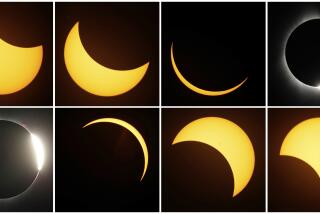This is Earendel, the most distant star ever seen by humans

Astronomers have discovered a star farther from Earth than any ever detected, a super-hot, super-bright giant that formed nearly 13 billion years ago at the dawn of the cosmos.
But this luminous blue star is long gone, so massive that it almost certainly exploded into bits just a few million years after emerging. Its swift demise makes it all the more incredible that an international team spotted it.
“We’re seeing the star as it was about 12.8 billion years ago, which puts it about 900 million years after the Big Bang,” said astronomer Brian Welch, a doctoral student at Johns Hopkins University and lead author of the study appearing in Wednesday’s edition of the journal Nature.
“We definitely just got lucky.”
He nicknamed it “Earendel,” an Old English name that means “morning star” or “rising light” — “a fitting name for a star that we have observed in a time often referred to as ‘`Cosmic Dawn.′”
Earendel is so far away that it took eons for its light to reach us. That light was captured by NASA’s Hubble Space Telescope.
The previous record-holder, Icarus, also a blue supergiant star spotted by Hubble, formed 9.4 billion years ago. That’s more than 4 billion years after the big bang.
In a distant galaxy more than 13 billion light-years from Earth, astronomers have discovered traces of the oldest known oxygen in the universe, as well as evidence that ancient stars “turned on” as early as 250 million years after the Big Bang.
In both stars’ discoveries, astronomers used a technique known as gravitational lensing to magnify the minuscule starlight. Gravity from clusters of galaxies closer to us — in the foreground — serve as a lens to magnify smaller objects in the background. If not for that, Icarus and Earendel would not have been discernible given their vast distances.
Although Hubble has spied galaxies as far away as 300 million to 400 million years after the universe-forming big bang, their individual stars are impossible to pick out.
“For those, we’re seeing the light from millions of stars all blended together,” Welch said. “In this one, it’s magnified so that we can see just this one star.”
Vinicius Placco of the National Space Foundation’s NOIRlab in Tucson described the findings as “amazing work.” He was not involved in the study.
Placco said based on the Hubble data, Earendel may well have been among the first generation of stars born after the big bang. Future observations by the newly launched James Webb Space Telescope should provide more details, he said, and “provide us with another piece of this cosmic puzzle that is the evolution of our universe.”
The telescope will be able to peer into the farthest reaches of space. The data it collects will allow scientists to better understand the formation of stars and galaxies.
Current data indicate Earendel was more than 50 times the size of our sun and an estimated 1 million times brighter, outsizing Icarus.
Earendel’s small, yet-to-mature home galaxy looked nothing like the pretty spiral galaxies photographed elsewhere by Hubble, according to Welch, but rather “kind of an awkward-looking, clumpy object.” Unlike Earendel, he said, this galaxy probably has survived, although in a different form after merging with other galaxies.
Earendel may have been the prominent star in a two-star, or binary, system, or even a triple- or quadruple-star system, Welch said. There’s a slight chance it could be a black hole, although the observations gathered in 2016 and 2019 suggest otherwise, he noted.
Regardless of its company, Earendel lasted barely a few million years before exploding as a supernova that went unobserved, as most do, Welch said. The most distant supernova seen by astronomers to date goes back 12 billion years.







